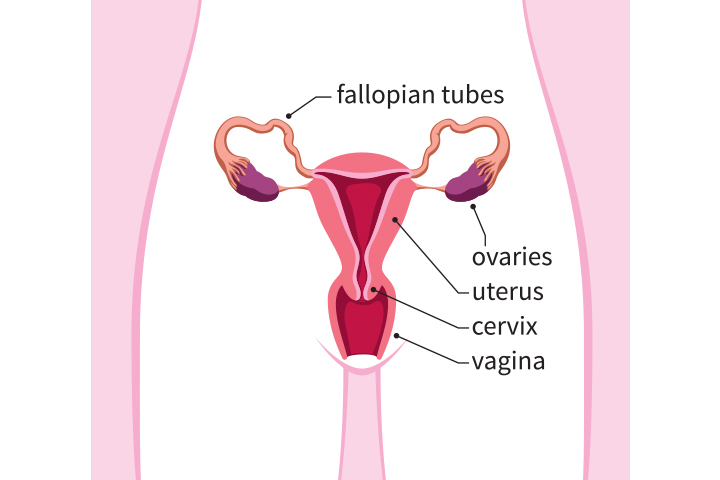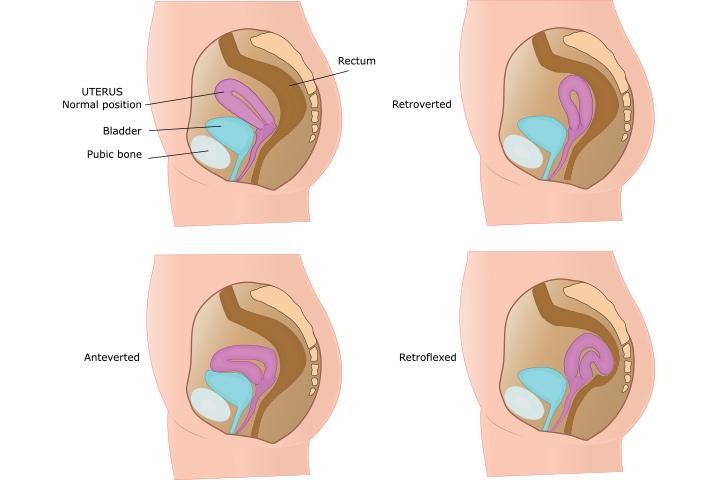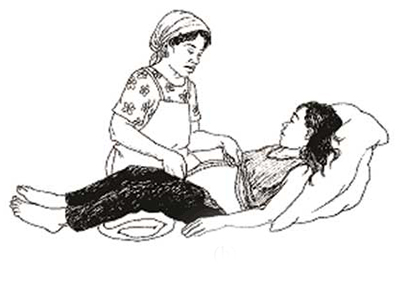If You Have Tilted Uterus Could You Not Know Youre Pregnant
When you recall of pregnancy, the commencement thing yous may envision is a growing belly. While this is a visible change of pregnancy that is difficult to ignore, myriad transformations occur inside a meaning woman'southward body. The well-nigh important change is the size of the uterus during pregnancy.
The uterus plays a crucial role in pregnancy every bit the abode of the infant, and it constantly expands during your gestation journeying to hold the developing fetus.
This post discusses interesting details about the uterus, including its size during and earlier pregnancy, functions, and positions. Information technology also mentions how to maintain a healthy uterus.
Uterus During Pregnancy
The uterus is a distensible organ the size of a closed fist. Information technology grows and changes to get big enough to conform a full-term baby. It is held in its position past ligaments, which stretch as the uterus grows.
Read on as we tell yous about what exactly the uterus does, how much does its size change, and how you can measure the organ and keep it healthy.
Size Of Uterus During Pregnancy
Equally you know, the uterus keeps irresolute in shape and size as your pregnancy progresses. The uterus expands between 500 and one,000 times its normal size (1). Let'south meet how the organ changes during each trimester.
The start trimester (0 to 12 weeks)
- At 12 weeks of pregnancy, the size of the uterus remains every bit minor as the size of a grapefruit.
- As your pregnancy progresses, the uterus grows, putting force per unit area on the float. This is when the frequency of urination increases (2).
- In the instance of twins or multiple pregnancies, the stretching of the uterus will be faster compared to that of a unmarried infant.
[ Read: Uterine Abnormalities During Pregnancy ]
The second trimester (fourteen-28 weeks)
- By the second trimester, the uterus grows to the size of a papaya. The uterus grows upward and develops outside the pelvic area.
- The uterus expands betwixt the naval expanse and the breasts and starts putting thrust on the other organs, pushing them away from their original positions (3). This may lead to some tensions in the ligaments and the surrounding muscles, leading to body aches and pains.
- In some cases, the naval may popular out because of the pressure put by the uterus on other organs.
The tertiary trimester (28-40 weeks)
- By the third trimester, your uterus volition go enlarged to the size of a watermelon. It will move from your pubic brim to the lower bottom of the rib muzzle.
- In one case you lot approach labor, your baby will descend into the pelvis.
Later on childbirth
Afterwards childbirth, the uterus shrinks back to its normal position and size. This process is known as involution, which will take almost 6 to 8 weeks (iv).
Apart from changing in size to accommodate the growing fetus, the uterus also plays other roles during pregnancy.
Functions Of The Uterus During Pregnancy
During pregnancy, the uterus:
- Accepts the fertilized ovum that passes through the fallopian tube.
- Creates the placenta for the development of the fetus.
- Nurtures the fetus with nutrients past developing blood vessels exclusively for this purpose.
- Contracts to facilitate the exit of the baby and the placenta through the vagina during childbirth.
- Mail service-delivery, information technology shrinks back and starts preparing for the next menstrual cycle.
- It helps the blood flow into the ovaries. It supports other organs such as the vagina, float, and rectum. It plays an of import office in sexual functions like triggering orgasm (5).
Interesting how of import this camouflaged organ is, right? Read on, and we will give more information almost the uterus and its functions.
How Big Is a Uterus? Normal Size Of A Uterus In Women
The size of the uterus varies from woman to adult female. It weighs approximately seventy to 125gm (six). However, the size of the uterus is based on factors such as age and hormonal atmospheric condition of a woman.
Size of the uterus:
- Before attaining puberty, the length of the uterus is nigh 3.5cm and thickness is approximately 1.4cm (7).
- After attaining puberty, the length is between 5 and 8cm, width is 3.5cm, and thickness is between ane.5 and 3cm.
- During pregnancy at term, the uterus measures 38cm in length and 24 to 26cm in width.
Merely like the size of the uterus, the position of the uterus likewise varies from woman to woman. It can be in an anteverted, anteflexed, or whatsoever other position.
[ Read: Uterine Prolapse During Pregnancy ]
What Is The Uterus Made Of?
The uterus is an inverted, pear-shaped, and a hollow, muscular reproductive organ (8) located in the pelvic region of a woman's body.
Image: iStock
It is fabricated of shine muscles lined with various glands. These muscles contract during orgasm, menstruation, and labor, whereas the glands grow thicker with the stimulation of ovarian hormones every month. If you do not get meaning during the ovulation period, the glands will cast off through the monthly menstrual bicycle.
The uterus extends into the vagina through the cervix, which is fabricated upwardly of fibromuscular tissues, and information technology controls the flow of cloth into and out of the uterus.
[ Read: Uterine Rupture During Pregnancy ]
Positions Of The Uterus
I of the factors that influence the position of the uterus is the degree of dilation of the float. The uterus normally lies right above the float and in front of the (inductive) rectum. The normal uterine position is straight and vertical.
Common uterus positions
The uterus position can too be anteverted or anteflexed, both of which are common.
Image: Shutterstock
- In the anteverted position, the uterus is bent frontward towards the bladder/ pubic bone and towards the front of the body.
- In anteflexed position, the uterus is rotated towards the pubic bone with a concave surface.
Uncommon uterus positions
Sure positions are tilted back towards the rectum.
- A retroverted uterus is tipped astern toward the rectum. Around 25% of women have this blazon of uterus.
- A retroflexed uterus is the reverse of the anteflexed uterus, as it takes a concave shape towards the rectum (9).
A retro uterus is not known to create whatever fertility bug. However, you lot might have pain during sexual intercourse.
A tilted uterus does not unremarkably create a problem during pregnancy, every bit the changing uterus will retain the forward-tipped position (10).
Measuring The Uterus During Pregnancy
Your physician might measure the size of your uterus, also called the fundal summit (fundus is the domed region at the tiptop of the uterus), to understand the fetal growth and development. The fundal peak is the measurement of the top of the pubic bone to the acme of the uterus, which determines the gestational age.
Note: It should be noted that the size of the uterus varies from woman to adult female and depends on top, weight, and age (eleven).
You, likewise, tin can measure the size of your uterus. Before we get into the various methods of measuring it, let'south see the initial steps:
- Lie downwards on your dorsum on the bed or the floor. While lying downwardly, yous should non experience any pain or dizziness.
- Locate your uterus by touching your tummy. If you are over 20 weeks pregnant, you can feel the uterus just above the navel. The uterus is hard, circular.
- At present, motility your fingers upward to feel the top of the uterus, which is also referred to every bit fundus.
- Proceed to locate your pubic bone. It is positioned just higher up your pubic hair line. The bone tip that you can experience is the pubic bone.
Once y'all locate the fundus and the pubic os, y'all can measure the fundal height using diverse methods.
[ Read: Uterine Fibroids During Pregnancy ]
1. Measuring fundal peak using a tape mensurate
- Measure the distance between your fundus and the pubic bone in centimeters using a tape.
- For example, if you are 24 weeks pregnant, then your uterus would ordinarily measure 22-26cm. The uterus usually grows 1cm in a calendar week or nigh 4cm in a calendar month.
Y'all can apply this method to track your pregnancy growth week by week. However, studies say that more research needs to be done to detect out the reliability of this method.
2. Measuring the fundal summit using the finger method
- If your uterus is below or above the abdomen button, so mensurate how many fingers below or above is the uterus from the bellybutton.
- The assumption is the fundal superlative increases by ii finger-widths every month.
- For instance, if yous are 4 two-finger-widths above the bellybutton, then it indicates 7 months gestation (see the above figure).
This method helps decide the gestational age in months (12).
If you lot find the fundal height different from the gestational week that y'all think you are in, talk to your doctor, and get your doubts cleared.
The size of the uterus during pregnancy plays an of import role in the well-being of your baby growing within. Next, nosotros await at how y'all tin can maintain the health of your uterus during pregnancy.
How To Keep Your Uterus Salubrious?
The best way to proceed your uterus healthy is to keep yourself good for you. Hither is how you can practise it:
- Make sure to eat right and engage in some forms of exercise to maintain.
- Consume omega-iii fatty acrid-rich nutrient.
- Quit smoking as it has harmful effects on the uterus.
- Do not concord your urine.
Every bit the pregnancy progresses gradually, you lot may not know the changes happening inside your body. Whether you can identify the changes or non, you demand to accept intendance of your uterus before, during, and later on pregnancy to avert any health issues to you lot or the baby.
[ Read: Cervical Length During Pregnancy ]
Practise y'all take whatsoever more than data to share? Permit us know in the comment department below.
References:
MomJunction'southward articles are written later on analyzing the research works of expert authors and institutions. Our references consist of resource established by authorities in their corresponding fields. You can larn more than about the authenticity of the data we present in our editorial policy.
1. The Developing Baby; Parents Heart
two. The First Trimester; John Hopkins Medicine
3. Pregnancy: Starting Out; Women's Specialists of New Mexico, Ltd
4. Ms. Rajdawinder Kaur1, et al.; A Quasi- Experimental Written report to Assess the Effectiveness of Early on Ambulation on Involution of Uterus amid Postnatal Mothers Admitted At SGRD Infirmary, Vallah, Sri Amritsar, Punjab; International Journal of Health Sciences and Inquiry
five. Role of the uterus in fertility, pregnancy, and developmental programming; American Society of Reproductive Medicine
6. Determining the Route and Method of Hysterectomy; Ethicon Endo-Surgery, Inc
7. Wellington de Paula Martins, et al.; Pelvic ultrasonography in children and teenagers; Scielo
8. Anatomy of Female person Pelvic Surface area; John Hopkins Medicine
9. Dr Anne Marie Coady; The uterus and the endometrium Common and unusual pathologies; The British Medical Ultrasound Society
10. Retroverted Uterus; Amend Health; Victoria State Government
11. Dr. Ajay Chiliad. Parmar, et al.; Sonographic Measurements Of Uterus And Its Correlation With Different Parameters In Parous And Nulliparous Women; International Journal of Medical Science and Pedagogy
12. Antenatal Care Module: 10. Estimating Gestational Historic period from Fundal Peak Measurement; The Open University
Recommended Articles:
- Progesterone Level During Pregnancy – Uses & Side Effects
- Retained Placenta: Causes, Symptoms, And Handling
- Placenta Previa During Pregnancy – Causes, Symptoms & Treatments Y'all Should Be Aware Of
The post-obit ii tabs change content below.
- Reviewer
- Author

Dr. Sangeeta Agrawal worked in Royal London, St. Bartholomew'due south, N Middlesex and Barnet General hospitals in London. Currently, she runs her own clinic in Mumbai. She is also attached to Bhatia Hospital, Breach Candy Hospital, Wockhardt Hospital, and Global Hospital. Her areas of expertise include obstetrics and gynecology, involving teenage care, antenatal, intrapartum, post-natal care, painless labor, fertility command, menopause... more

Shreeja holds a postgraduate degree in Chemistry and diploma in Drug Regulatory Diplomacy. Before joining MomJunction, she worked as a research analyst with a leading multinational pharmaceutical visitor. Her interest in the field of medical research has developed her passion for writing enquiry-based articles. Every bit a writer, she aims at providing informative articles on health and pharma, especially related to... more than
Source: https://www.momjunction.com/articles/uterus-during-pregnancy_00395837/




0 Response to "If You Have Tilted Uterus Could You Not Know Youre Pregnant"
Postar um comentário